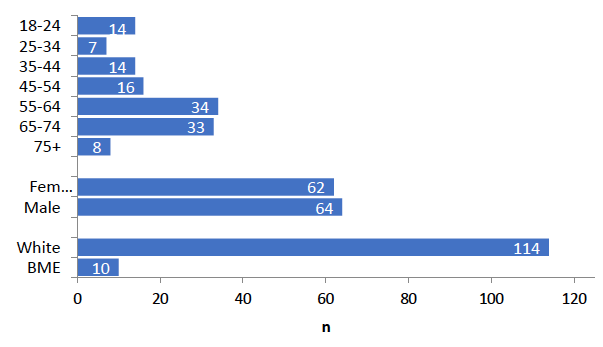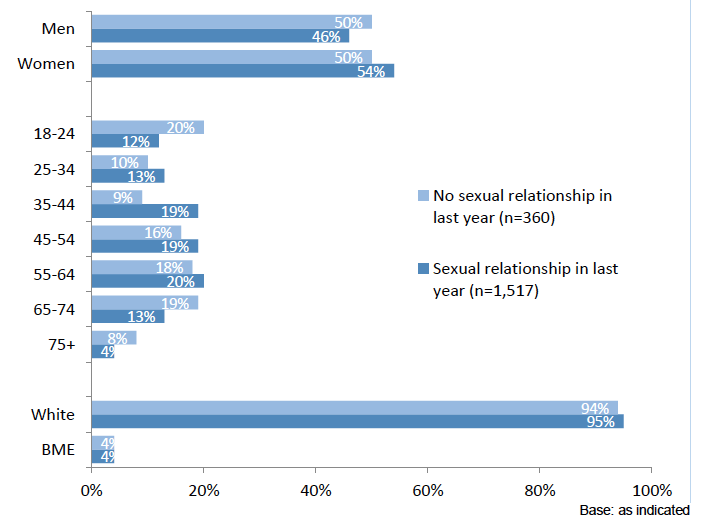Sexual Health & Wellbeing Survey: Main Findings
This report summarises findings from an online survey of 1,500 adults in Scotland who had been in a sexual relationship in the past year.
1 Background and method
Policy context and purpose of the survey
1.1 The Scottish Government's Sexual Health and Blood Borne Virus Framework (2011-2015) integrates sexual health, HIV, hepatitis C and hepatitis B in one strategy, promoting a holistic, multi-agency approach. The Framework is based on foundations provided by previous policy such as the sexual health strategy, Respect and Responsibility, and the Hepatitis C Action Plan. It also maintains a policy focus on HIV which was signalled by the publication of the HIV Action Plan in 2009, and establishes a policy landscape in Scotland for hepatitis B.
1.2 The Framework includes a set of five outcomes and associated indicators to chart progress. The Scottish Government commissioned YouGov to undertake a survey of adults' experiences of sexual health and well-being. The survey was undertaken to gather baseline data, from a representative sample of the Scottish population, against which progress on two of the outcomes will be monitored:
- Outcome 4: Sexual relationships are free from coercion and harm;
- Outcome 5: A society where the attitudes of individuals, the public, professionals and the media in Scotland towards sexual health and blood-borne viruses are positive, non-stigmatising and supportive.
1.3 The main themes of the survey, the full text of which is provided in the Annex, were:
- How easy people find it to talk about sex with a sexual partner;
- General health and the impact of specific conditions;
- Levels of satisfaction with relationships and experiences, including regret;
- The impacts of alcohol and drug use on experiences;
- Experiences of abuse by a partner;
- Advice and support.
1.4 The results of the survey provide a basis for assessing the extent to which measures included in the Framework are contributing to improvements in important sexual health and wellbeing outcomes across the Scottish adult population. The Scottish Government will share the findings with networks and partners who have a role in determining policies on sexual health or are responsible for delivering sexual health and wellbeing interventions at the local level.
1.5 This report provides a summary of responses to individual questions and also looks at the data provided by three respondent sub-groups: younger people; LGB respondents; and those with a long-term disability or health condition.
1.6 As no-one who took part in the survey described themselves as 'transgender', LGB is used throughout the report instead of the more conventional 'LGBT' as this more accurately describes the composition of this group of respondents.
Method and Analysis
1.7 Between the 25th February and the 4th March 2014, 1,516 Scottish adults aged 18 and over were surveyed through the YouGov online research panel. The figures in this report have been weighted to be representative by gender, region, ethnicity and social grade.
1.8 As the Scottish Government was interested in data which would help to improve understanding of recent or current relationships, respondents had to have been in a sexual relationship in the last 12 months. Rather than being a survey of all Scottish adults it is best described as a survey of Scottish adults who are, or have been, in a sexual relationship in the last year.
1.9 The application of this criterion for participation meant that the proportion of respondents who were aged 70 and older was not representative of the Scottish population. Therefore the sample was not weighted by age, but other demographic factors do not appear to have been affected by this requirement.
1.10 Due to the representative nature of the sample, numbers of responses for certain demographic characteristics are small - for example, there were just 91 LGB (85 once weighted) and 154 minority ethnic (59 once weighted) respondents. Care therefore needs to be taken in drawing any generalisations for such groups within wider Scottish society from the findings of this survey. Sub-group sample numbers are provided throughout the report.
1.11 The questions used in the survey had previously been cognitively tested for respondent comprehension. Several of the questions were used with the agreement of researchers at University College London who had developed them for use in the NATSAL and SexUnzipped surveys.
1.12 The report flags significant differences between survey responses for sub-groups identified in the demographic breakdown in Table 1: gender; age; sexual orientation; marital status; social grade; and disability.
1.13 Where the differences between sub-groups are noted in the text, or are highlighted with a red circle in the charts, they are statistically significant differences that have been tested at the 95% confidence level.
1.14 The report contains a small number of comparisons with NATSAL-3, a large study that interviewed over 15,000 people aged between 16 and 74 across Great Britain between 2010 and 2012. Some of the questions are a direct or close match with NATSAL-3 ones. However, some caveats apply when comparing the two surveys. Firstly, the NATSAL-3 data that have to date been published are for Britain as a whole, although analysis of the Scottish sample (1,240) will be available in 2014. Secondly, NATSAL was carried out face-to-face in the home and includes a much more detailed set of questions; although it was also self-completion it cannot be directly compared to an online approach due to the potential effects of different methods.
Table 1: Sample breakdown by demographics
| Demographics |
Unweighted (n) |
Weighted (n) |
|
|---|---|---|---|
| Gender |
Men |
815 |
675 |
| Women |
749 |
765 |
|
| Age |
18-29 |
260 |
258 |
| 30-39 |
243 |
246 |
|
| 40-49 |
301 |
307 |
|
| 50-59 |
303 |
303 |
|
| 60-69 |
301 |
295 |
|
| 70+ |
108 |
108 |
|
| Social grade |
ABC1 |
700 |
680 |
| C2DE |
816 |
836 |
|
| Ethnicity |
White |
1,332 |
1,427 |
| Minority ethnic |
154 |
59 |
|
| Sexual orientation |
Heterosexual |
1,409 |
1,415 |
| LGB |
91 |
85 |
|
| Disability/ limiting illness |
Limited a lot |
124 |
127 |
| Limited a little |
228 |
228 |
|
| No |
1,164 |
1,161 |
|
| Health condition |
Condition(s) affecting sexual activity |
362 |
365 |
| No condition(s) affecting sexual activity |
1,141 |
1,145 |
|
| Relationship status |
Married |
883 |
884 |
| Living as married |
229 |
233 |
|
| Divorced / separated |
70 |
71 |
|
| Widowed |
19 |
20 |
|
| Never married |
261 |
254 |
|
| Civil partnership |
11 |
11 |
|
| Urban/ rural |
Urban |
983 |
991 |
| Town & Fringe |
171 |
172 |
|
| Rural |
274 |
269 |
|
| Working status |
Working |
930 |
931 |
| Full time student |
102 |
96 |
|
| Retired |
336 |
333 |
|
| Unemployed |
55 |
54 |
|
| Not working |
72 |
78 |
|
| Other |
21 |
24 |
|
| Region |
Ayrshire & Arran |
97 |
103 |
| Borders |
44 |
45 |
|
| Fife |
108 |
108 |
|
| Greater Glasgow |
314 |
352 |
|
| Highland, Orkney, Shetland and Western Isles |
119 |
111 |
|
| Lanarkshire |
136 |
149 |
|
| Grampian |
152 |
148 |
|
| Lothian |
284 |
234 |
|
| Tayside |
130 |
128 |
|
| Forth Valley |
92 |
99 |
|
| Dumfries & Galloway |
39 |
40 |
Screen-out and drop-out analysis
1.15 In total 2,057 Scottish adults started the survey with 414 screened out because of the sexual relationship in the last year criterion. A further 126 started the survey but withdrew before completing it. This left 1,516 full completions.
1.16 YouGov panellists do not pick which surveys they can access; they are sampled and invited through an initial individualised e-mail which does not indicate the content of the survey or the client.
Drop-outs
1.17 One hundred and twenty-six people dropped out after they had started the survey (Chart 1). At just 6% of those who began the survey, the drop-out rate is lower than most YouGov surveys. An introduction, which outlined the subject-matter and purpose, was placed before the screening-out question (being in a sexual relationship in the last 12 months) and 43 people dropped out after reading this. The next page contained the screening-out question.
1.18 The largest number of drop-outs occurred during the first section of the questionnaire as the scope of the questions became clearer.
1.19 There were no gender differences in terms of dropping out, although those aged 55 and older were more likely to withdraw from completion (Chart 1). YouGov experience is that many who choose not complete a survey which they have started do so because they feel it lacks relevance for them personally or because of a perception that it is aimed at a different age group - in this case a younger one.
Chart 1: Demographic composition of those who dropped out during the survey

Screen-outs
1.20 Four hundred and fourteen people who were sent the survey were screened out as they were either not in a sexual relationship, or had not been in the last 12 months (360 - 87%), or they preferred not to say (54 - 13%) (Chart 2). Of those who preferred not to say, 32 were men and 22 women, and in terms of their ethnicity, 46 were white, six were minority ethnic and two preferred not to say. Screen-outs had an older profile, with 15 aged 65 or older and 19 of them aged 45-64. Six of those aged between 18 and 24 preferred not to say as did eight of those aged 25-34.
Chart 2: Demographic composition of those who were screened out

Base: as indicated
1.21 There were no gender differences between those who were not currently in a sexual relationship nor had been in the last year (Chart 2). At the two ends of the age spectrum, the youngest (18-24) and oldest (65 plus) groups are less likely to have been in a sexual relationship in the last year.
Contact
Email: Fiona MacDonald
There is a problem
Thanks for your feedback